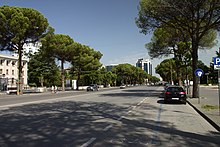Dëshmorët e Kombit Boulevard
- View a machine-translated version of the German article.
- Machine translation, like DeepL or Google Translate, is a useful starting point for translations, but translators must revise errors as necessary and confirm that the translation is accurate, rather than simply copy-pasting machine-translated text into the English Wikipedia.
- Consider adding a topic to this template: there are already 9,121 articles in the main category, and specifying
|topic=will aid in categorization. - Do not translate text that appears unreliable or low-quality. If possible, verify the text with references provided in the foreign-language article.
- You must provide copyright attribution in the edit summary accompanying your translation by providing an interlanguage link to the source of your translation. A model attribution edit summary is
Content in this edit is translated from the existing German Wikipedia article at [[:de:Bulevardi Dëshmorët e Kombit]]; see its history for attribution. - You may also add the template
{{Translated|de|Bulevardi Dëshmorët e Kombit}}to the talk page. - For more guidance, see Wikipedia:Translation.
 View of the Boulevard looking northward. | |
| Type | Public Boulevard |
|---|---|
| Length | 1 km |
| Location | Tirana  Albania Albania |
| From | Skanderbeg Square |
| To | Mother Teresa Square |
| Construction | |
| Construction start | 1939 |
| Completion | 1941 |
The Dëshmorët e Kombit Boulevard (English: Boulevard of the Martyrs of the Nation) is a major thoroughfare in Tirana, Albania. It was initially designed by Armando Brasini in 1925. Brasini's master plan was later amended by Florestano di Fausto, and in 1939 by Gherardo Bosio following the Italian invasion of Albania.
The wide thoroughfare was initially named after King Zog,[1] and after the 1939 invasion was renamed Viale del Impero ("Avenue of the [Italian] Empire").[2] In 1934 to 1935, a bridge was built over the boulevard by Gjovalin Gjadri.[3] During the communist era in Albania, major parades regularly took place including on Liberation Day and International Workers Day.
Many buildings are located along this boulevard, including the Presidential Palace, the Prime Minister's Office, the Palace of Congress, the Rogner Hotel and the University of Tirana. The boulevard enters the city centre from the south and intersects with Bajram Curri Boulevard near the Rinia Park. It then becomes part of Skanderbeg Square and continues north of the centre to Zogu I Boulevard.
During communism in Albania and in the 1990s, the boulevard served as an important social landmark where locals practiced the nightly stroll, also known as xhiro from Italian giro.
The boulevard was immortalised by Edi Hila in a series of paintings titled Martyrs of the Nation Boulevard.[4]
Gallery
-
 The view from the Pyramide
The view from the Pyramide -
 Old picture of Tirana's car-free main boulevard
Old picture of Tirana's car-free main boulevard -
 View from the south end of Mother Teresa Square
View from the south end of Mother Teresa Square - The Prime Minister's Office building
-
 The street in 2022
The street in 2022
References
- ^ Ingrid Bleta (June 2010). "Influences of political regime shifts on the urban scene of a capital city - Case study: Tirana". Middle East Technical University.
- ^ Vickers, Miranda (1999). The Albanians: A Modern History. Bloomsbury Academic. ISBN 978-1-86064-541-9.
- ^ "Boulevard Deshmoret e Kombit Bridge (Tirana, 1935)". Structurae. Retrieved 2021-05-07.
- ^ "Edi Hila: Painter of Transformation - Announcements - e-flux". www.e-flux.com. Retrieved 2018-06-11.
- v
- t
- e
| Urban | |
|---|---|
| Rural | |
| Landmarks |
|
- Bank of Albania
- Tirana Bank
- Logistic Park
- Stock Exchange
- Union Bank
- Constitutional Court
- Mayor
- Municipal Council
- Parliament
- Presidential Palace
- Presidential Office
- Prime Minister's Office
- Supreme Court
| Transport | |
|---|---|
| Squares |
|
- Academy of Armed Forces
- Academy of Sciences
- Albanian International School
- Arben Broci High School
- Academy of Albanological Studies
- European University
- Luarasi University
- Marin Barleti University
- Marubi Academy of Film and Multimedia
- Kristal University
- Polytechnic University
- Qemal Stafa High School
- Tirana International School
- Agricultural University
- University of Arts
- University of New York
- University of Sports
- University of Tirana
| Religion | |
|---|---|
| Museums |
|
| Monuments | |
| Sports | |
| Media |
 Category
Category
 | This article about a specific location in Tirana County, Albania, is a stub. You can help Wikipedia by expanding it. |
- v
- t
- e
This European road or road transport-related article is a stub. You can help Wikipedia by expanding it. |
- v
- t
- e

















